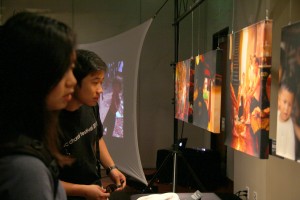Exhibit reflects empathy
On Tuesday, USC World Vision ACT:S hosted an art exhibit and mattress vigil in the Ronald Tutor Center Grand Ballroom as part of Empathy Week, a weeklong campaign to raise awareness and advocacy against human trafficking.

Expression · Students browse through the displayed art at USC World Vision ACT:S’ art exhibit. The event is a part of Empathy Week. – Min Haeng Cho | Daily Trojan
The event was sponsored by the Undergraduate Student Government, and USC student organizations involved in the event included the USC Korean Campus Ministries, the United Nations Children’s Fund at USC, Student Coalition Against Labor Exploitation, Student Coalition for Asian Pacific Empowerment and USC’s United House of Prayer.
Volunteers from the organizations provided guided tours with a multimedia experience featuring film, photography and artifacts that served to connect students to the stories of real victims of child sex trafficking.
Volunteer Brandon Little said that the exhibit was launched in order to allow students to feel empathy for those involved in human trafficking.
“What we really want to strive for is that next level, which is empathy when you actually feel for someone, enter into their situation, and help find a solution,” Little said.
During a presentation during the exhibit, volunteers Natalie Zamudio and Jasmine Kellison shared the tragic stories of young girls in Southeast Asia, Russia, Mexico and the United States. One table displayed the syphilis medication of a 13-year-old Mexican girl named Rita. Her vulnerability was exploited by pimps, who hooked Rita on drugs and forced her to turn to prostitution to satisfy her addiction. With the help of iEmpathize — an organization working to end child exploitation — and its supporters, however, she now lives in a recovery facility.
“By sharing these stories, we hope people will move from apathy to empathizing,” Kellison said. “We want them to step into these people’s shoes and realize that they don’t have to just sit back and let this happen.”
The exhibit also included a mattress vigil where participants could sit on a bed symbolizing places where children are exploited, and students were able to become advocates for the victims by taking their place on the bed. This exercise was free, but a $5 donation was suggested. one hundred percent of the proceeds went to the iEmpathize efforts in the United States and Mexico.
Guido Hajenius, branch coordinator for the NGO iEmpathize Los Angeles, was enthusiastic about engaging the USC community and advocating for awareness.
“The Empathy Exhibit is about empowering and giving students the tools to do more than just know about an issue,” Hajenius said. “We want them to share these stories and establish personal connections.”

